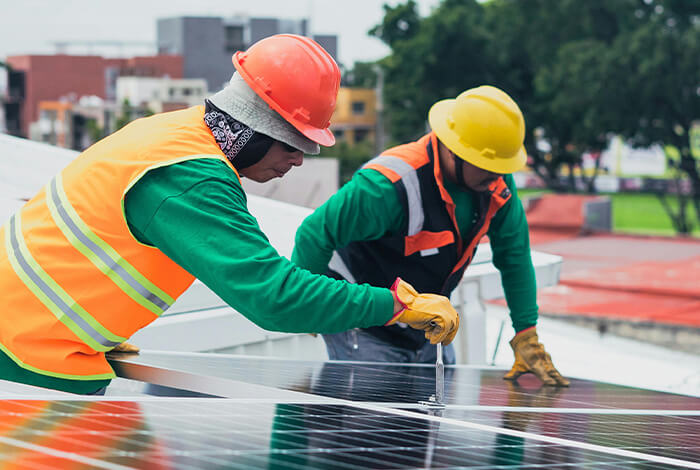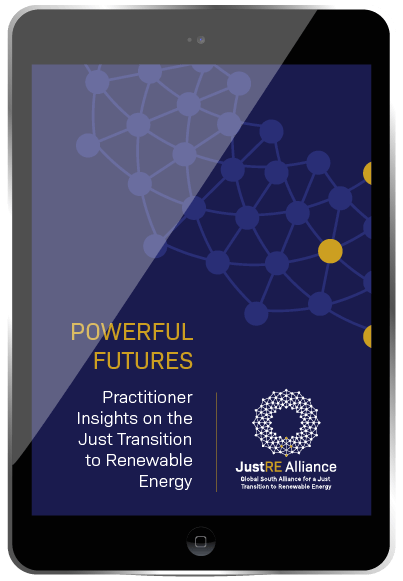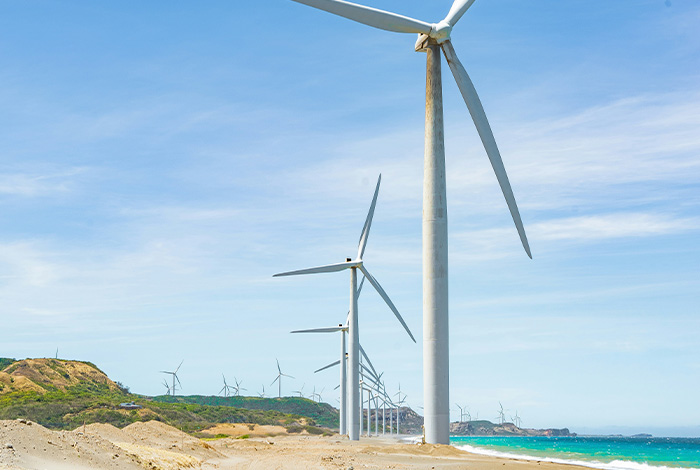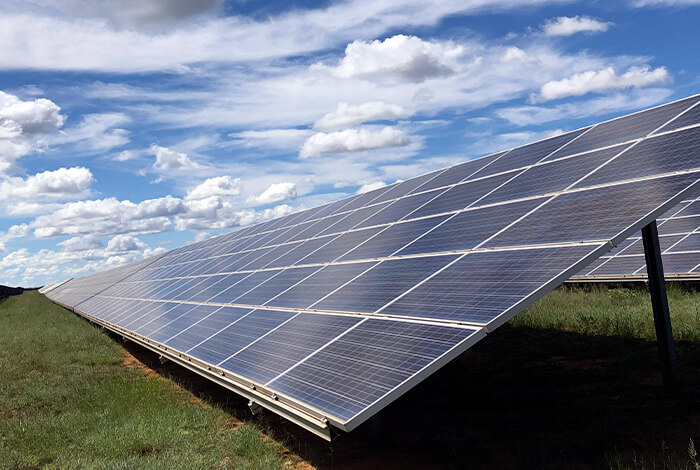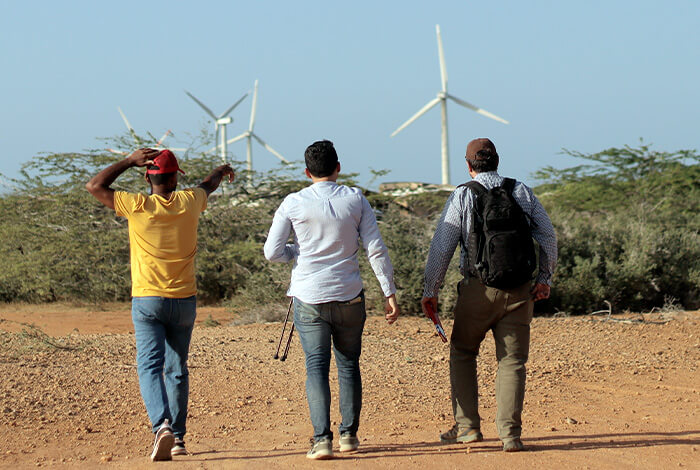The energy transition depends heavily on the availability of transition minerals and resilient supply chains. This chapter focuses on several key social risks and opportunities within the RE supply chain: sourcing transition minerals, labour rights in manufacturing and recycling, and local economic development.
Context
With solar and wind equipment supply chains maturing and growing in number, the mining of transition minerals to meet the global demand is intensifying, as are associated risks, including to human rights, labour rights and biodiversity conservation. To meet Net Zero goals by 2050, the International Energy Agency (IEA) estimates a sixfold increase in demand for transition minerals.[2]International Energy Agency (IEA), 2022, The Role of Critical World Energy Outlook Special Report Minerals in Clean Energy Transitions Companies and countries in the Global North are scrambling to secure their mineral supply chains, half of which are linked to the Global South, with 50% of the world’s transition minerals in Indigenous territories.[3]Indigenous Peoples and the Just Transition, 2024, Declaration of Indigenous Peoples’ Participants in the Conference on Indigenous Peoples and the Just Transition
Data from the Business & Human Rights Resource Centre’s Transition Minerals Tracker reveals human rights abuses related to transition mineral mining. The Tracker currently includes 631 allegations of abuse from 2010-2023 associated with the mining of seven of the transition minerals: bauxite, cobalt, copper, lithium, manganese, nickel, and zinc. These allegations include environmental, land and Indigenous Peoples’ rights violations, with a significant increase in labour rights violations and worker fatalities.[4]Business & Human Rights Resource Centre, 2024, Transition Minerals Tracker: 2024 Analysis Indigenous Peoples are particularly vulnerable to the impacts of mining activities.[5]Graziela Dias Blanco et. a.l, 2023, The impacts of mining on food sovereignty and security of Indigenous people: a global review
Moreover, workers can be exposed to unsafe conditions in mineral processing plants. A case example is in Indonesia, where there were 57 fatalities in Chinese-owned nickel smelters from 2015 to 2020.[6]Business & Human Rights Resource Centre, 2023, Indonesia: Unsafe working conditions at Chinese-owned nickel smelters led to 76 injuries and 57 deaths from 2015 to 2020, CSO report shows Similarly, in the production of polysilicon (a key material in solar modules), allegations of forced labour in the Xinjiang region of China persist.[7]Climate Rights International, 2022, Nickel Unearthed, The Human and Climate Costs of Indonesia’s Nickel Industry According to multiple sources, the Uyghur people and other minority groups in the Xinjiang region are being denied the right to free choice of employment as defined in Article 23 of the U.N. Declaration of Human Rights.[8]Bill Bartles, ABC News Australia, 2018, China defends ‘vocational training centres’ amid international pressure over mass Uighur detentions
Construction companies and their staff also form part of the supply chain. The opportunity exists to stimulate the regional economy during the lucrative construction phase of power plants’ development, when various businesses can be contracted or subcontracted and many jobs are created. In some cases, labour and contractors are brought in from other regions. This can cause resentment among the local communities and limits the benefits that stay in the area. The time span of the local socio economic benefits depends on several factors, such as the development of the RE industry in the area, policy and regulation or agreements with local populations.
Poor labour conditions in collecting, segregating, and treating solar panel waste are an issue, particularly in the Global South. Solar panels contain toxic heavy metals such as cadmium and include shatterable elements like glass, making them difficult to disassemble safely.
Emerging Good Practice
There are emerging good practices in inclusive RE supply chains. Tools are being developed to support procurement and supply chain managers with traceability and informed decision-making, such as Supply Trace[9]Supply Trace, Home [Accessed in June 2024] and the BHRRC Transition Mineral Tracker. Some RE developers are now performing more robust and gender-sensitive human rights due diligence processes as part of procurement and supply chain management, and this should be encouraged to become the norm.[10]Business & Human Rights Resource Centre, 2023, Renewable Energy & Human Rights Benchmark: Key Findings From the Wind and Solar Sectors This section focuses on three main aspects of the supply chain: transition mineral mining, manufacturing, and supplier development.
The availability of critical minerals in the Global South makes it essential to avoid the common exploitative dynamics of extractive industries, and to ensure that the value created from these deposits remains within the Global South.
When mines are proposed, and during their operation and decommissioning, communities should be meaningfully engaged (see Chapter 4), including, where applicable, through FPIC, and receive fair compensation and benefit-sharing arrangements that enable shared prosperity. Particular attention should also be paid to managing pollution risks resulting from operations, waste storage, and transportation associated with a mine, including harm to potable water and soil health. High standards for mine closure procedures and guarantees for the integration of local and artisanal miners should also be adopted.[11]Solidaridad, 2018, CRAFT Code for Risk Mitigation in Mining Facilitates Responsible Sourcing of Minerals
Mining companies should adopt policies to guarantee worker safety, ensure payment of fair living wages, and guarantee workers’ freedom of association and right to collective bargaining with trade unions. Ideally, companies should include workers and their unions in upstream project conception and design to support models of shared prosperity through decent work and new models of co-management, ownership, and cooperation. Lastly, mining companies should implement gender-sensitive human rights, environmental due diligence in operations and supply chains, and access to remedy through effective grievance mechanisms built on safe and inclusive worker and community engagement.[12]Responsible Energy Initiative Philippines, 2024, Renewable energy to responsible energy: A call to action
The industry is trying various approaches to respond to labour rights risks in manufacturing. Companies with more robust sustainable procurement approaches set expectations that labour and gender standards, occupational health and safety, and worker representation, among other responsible practices, are included in supplier codes of conduct and contracts.[17]REI India, Responsible Energy Initiative Call to Action — India [Accessed in June 2024]
To avoid enabling negative impacts on the Uyghur people, JustRE’s experience suggests that some RE companies are attempting to buy from manufacturers outside of China, in countries where supply chain transparency and scrutiny are perceived to be more robust and standards more rigorously upheld. However, diversifying the supply chain is proving challenging for procurers around the world. Currently, over 80% of solar panels’ components and stages (including polysilicon, ingots, wafers, cells, and modules) are produced in China.[18]IEA (2022), Solar PV Global Supply Chains, IEA, Paris, Licence: CC BY 4.0 Countries like India seek to boost local manufacturing, demonstrating how acting on these new norms can support national ambitions. Whilst avoiding high-risk suppliers is not always possible, a great deal can be learned from other industries (such as textiles and apparel) about effective and constructive engagement for supplier-by-supplier or group-based improvement. Leading investors are encouraging this practice in their investees.[19] Jag Lamda, PV Magazine, 2024, Solar panel production is struggling to stay clear of forced labor
Whilst most prominent solar and wind energy equipment manufacturers are private, business models from other industries can point to more inclusive structures that could be applied to organisations in the RE supply chain. For instance, cooperatives or employee-ownership approaches may also apply to RE manufacturing. These models incorporate shared decision-making and profit sharing (examples include jam maker Wilkin & Sons and polymers manufacturer Scott Bader).
Owing to the substantial number of jobs and business opportunities created in the construction phase of new projects, this phase offers a key entry point into supporting the local economy and engagement with local communities. Developers need to understand how the capabilities of local labour and businesses compare to the expertise required during the construction using participatory technical skills and business competency audits as part of early community engagement. The engagement can expedite recruitment, ensure transparency, and build social acceptance and rapport.
Ideally, key gaps would be addressed through capacity-building programmes that empower individuals and businesses to access work and contracts beyond construction. While RE companies may not always be in a position to invest in such a detailed and costly exercise before operations and revenue flow, in some countries, this task may be undertaken by an existing RE company as part of its supplier or business development investment requirements.[21]Valve+Meter, 2023, Solar Panels Made In USA vs. China: Past, Present, and Future Collectively planned and implemented strategic supplier development investments could significantly contribute towards economic development, as evidenced in other sectors, especially in areas with a high concentration of renewable energy projects.
Relevant Stakeholder Insights
Below, we share some key elements to consider when working with the private sector, policymakers, and communities towards more inclusive RE supply chains.
Future glimpse
Dominique has wanted to work at the Co-op ever since the solar panel manufacturing plant leader gave a talk at her college in 2025. The thought of having a say in how her company was run, even at a junior level, inspired her. When she learned a role was available in the supplier engagement team, she jumped at it. What if she could support their suppliers in adopting similar models? Dominique was pleasantly surprised by how many local suppliers were in their network and were already keen to learn. Even some of their clients wanted to know more. She’d heard they, too, saw this as a way of attracting the best talent. She feels excited and nervous as she gets ready to talk with her fellow members of the Just Transition Minerals for Renewable Energy Alliance.
Today, they heard from her friend Ngoy from the artisanal mining collective in the Democratic Republic of Congo about the results of their ecosystem and community regeneration efforts. Dominique loves that she has gained a friend through their supplier engagement programme. From what she has heard, none of her predecessors got to know people so far into their supply chain, but they never had the data and visibility she had at her fingertips. She hopes to save enough flight credits to make it to Ngoy’s family celebrations next year.
- Business & Human Rights Resource Centre, 2024, Transition Minerals Tracker: 2024 Analysis
- Teresa Kramarz et. al., 2021, Governing the Dark Side of Renewable Energy: A Typology of Global Displacements, Energy Research and Social Science, Vol. 74
- Business for Social Responsibility, 2022, Addressing Human Rights Risks in Renewable Energy Supply Chains, BSR Blog.
- [1] [3] Indigenous Peoples and the Just Transition, 2024, Declaration of Indigenous Peoples’ Participants in the Conference on Indigenous Peoples and the Just Transition
- [2] International Energy Agency (IEA), 2022, The Role of Critical World Energy Outlook Special Report Minerals in Clean Energy Transitions
- [4] Business & Human Rights Resource Centre, 2024, Transition Minerals Tracker: 2024 Analysis
- [5] Graziela Dias Blanco et. a.l, 2023, The impacts of mining on food sovereignty and security of Indigenous people: a global review
- [6] Business & Human Rights Resource Centre, 2023, Indonesia: Unsafe working conditions at Chinese-owned nickel smelters led to 76 injuries and 57 deaths from 2015 to 2020, CSO report shows
- [7] Climate Rights International, 2022, Nickel Unearthed, The Human and Climate Costs of Indonesia’s Nickel Industry
- [8] Bill Bartles, ABC News Australia, 2018, China defends ‘vocational training centres’ amid international pressure over mass Uighur detentions
- [9] Supply Trace, Home [Accessed in June 2024]
- [10] Business & Human Rights Resource Centre, 2023, Renewable Energy & Human Rights Benchmark: Key Findings From the Wind and Solar Sectors
- [11] Solidaridad, 2018, CRAFT Code for Risk Mitigation in Mining Facilitates Responsible Sourcing of Minerals
- [12] Responsible Energy Initiative Philippines, 2024, Renewable energy to responsible energy: A call to action
- [13] Business & Human Rights Resource Centre, 2023, Indonesia: Uncontacted tribe might not survive destruction that will result from a nickel project concession for electric car batteries, report alleges
- [14] Business & Human Rights Resource Centre, 2023, BASF’s response
- [15] BASF, 2024, BASF decides against investment in nickel-cobalt refining complex in Indonesia
- [16] The Earthshot Prize, 2023, GRST
- [17] REI India, Responsible Energy Initiative Call to Action — India [Accessed in June 2024]
- [18] IEA (2022), Solar PV Global Supply Chains, IEA, Paris, Licence: CC BY 4.0
- [19] Jag Lamda, PV Magazine, 2024, Solar panel production is struggling to stay clear of forced labor
- [20] Eventide, 2022, Eradicating Forced Labor from Solar Supply Chains: Eventide’s Approach
- [21] Valve+Meter, 2023, Solar Panels Made In USA vs. China: Past, Present, and Future
